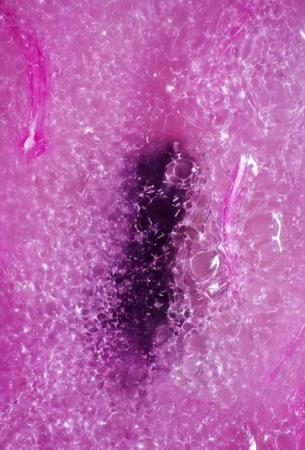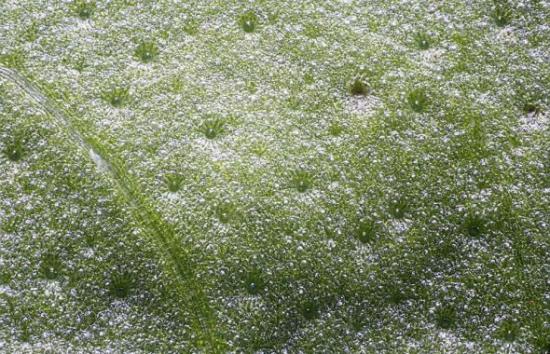北京时间7月21日消息,从罗勒叶到红酒,67岁的美国科学家加里·格林伯格将一系列日常食品和饮料进行放大,而后拍照。照片的清晰度引人注目,所呈现的细节更是令人叹为观止。借助于定制的3D显微镜,格林伯格将食品和饮料放大300倍,揭示出它们独特的结构。由于兼具科学性和美感,他的作品给人留下难以磨灭的印象。

仙粉黛玫瑰红酒样本放大300倍

放大125倍的迷迭香

火龙果放大125倍

草莓放大125倍

放大125倍的糖

放大125倍的罗勒叶
家住夏威夷毛伊岛的格林伯格表示:“这种显微镜是进行科学和艺术探索的一个强大工具。显微镜呈现的景象永远不会让我感到厌烦。每一次看到新的样本,我都会陷入惊奇之中。大自然的秘密隐藏起来,如果近距离观察,你就会发现这些秘密无处不在。显微镜是揭示自然秘密的最生动的方式之一。发现新事物让我获得莫大的满足感。展现黄瓜中央一个小籽的照片是我最喜欢的作品之一。它让人意想不到,非常精巧,充满生命和运动气息。”
格林伯格定制的3D显微镜由他自己发明,过去21年时间里,他一直潜心拍摄高清晰照片。他说:“很多因素促使我使用显微镜拍摄引人注目的照片。镜头的品质、照明、照相机和显微镜的类型都决定着最后的画质。拍摄三维物体的显微照片有一定难度,因为光学显微镜的景深很浅。换句话说,照相机只能看到焦点对准的物体的一小部分,前景和背景失焦。通过在不同聚焦水平下拍摄一系列照片,我克服了这种局限性。为了获得一幅充分聚焦的照片,我利用电脑程序分析每一幅照片,选择焦点对准的部分,剪掉失焦的部分。”
格林伯格称:“所有聚焦的部分都进行无缝拼接,呈现聚焦而锐利的前景和背景。借助于这项技术,一幅幅展现3D物体的生动照片就此诞生。”他在自家实验室进行艺术创作,在毛伊岛的夏威夷大学天文学学院进行科学研究。他使用的样本和标本来自世界各地的研究人员。最近,美国宇航局找到了他,让他分析阿波罗任务期间收集的月球沙样本。
格林伯格说:“我通常参与一些特殊的项目,确定所研究样本的属性。最近,我获得宇航局的批准,研究40年前阿波罗任务期间收集的月球沙样本。前两年,我一直使用显微镜拍摄花卉和食品。我的样本来自世界各地的研究人员,他们都对样本在3D显微镜下将呈现怎样的一面充满兴趣。就这样,我拍摄了大量不同样本,包括神经细胞和微电子元件。”
公众对其作品的反应仍让格林伯格兴奋不已。他说:“看到3D显微镜下的食品或者沙子等普通物品,人们都是一副惊讶的表情,看到他们的这种反应是我最兴奋的时刻。他们告诉我此前从未用同样的方式观察事物。”
生物探索推荐英文原文
Peering into a hidden world: Stunning close-up images reveal alien landscapes of everyday food and drink
Read more: https://www.dailymail.co.uk/sciencetech/article-2016182/Gary-Greenbergs-stunning-close-images-reveal-alien-landscapes-everyday-food-drink.html#ixzz1T5FwmJq7
'The secrets of nature are hidden, yet they are everywhere if you look closely. The microscope is one of the most dramatic ways of revealing the secrets of nature. I get a huge amount of enjoyment from discovering new things.
'I think my image of a tiny seed emerging from the centre of a cucumber is one of my favourite photographs. It's so unexpected, and delicate, and full of life and motion.'
Mr Greenberg, who invented and built his custom-made 3D microscopes, has been producing his high-definition images for the past 21 years.
'There are many factors go into making a compelling photograph through the microscope,' he said. 'The quality of the lens, the lighting, the camera, and the type of microscope all make a big difference.
'Microscopic photographs of three-dimensional objects are difficult to produce because light microscopes have very shallow depth of focus.
'In other words, the camera can only see a thin section of the object in-focus, with the foreground and background being out-of-focus.
'I overcome this limitation by photographing a series of images taken at different focus levels. To produce a fully-focused image, a computer program analyses each image in the series, selecting the in-focus portions, and discarding the out-of-focus portions of each image in the series.
'All of the in-focus portions are then seamlessly combined into a single image that is sharply focused from foreground to background.
'The result of all this technology is a dramatic, more three-dimensional representation of the object.'
Mr Greenberg carries out his artistic work at his home lab and his scientific work at the University of Hawaii Institute for Astronomy in Maui.
Receiving samples and specimens from researchers all over the world, he has recently been approached by Nasa to examine moon sand collected during an Apollo mission.
'I generally have specific projects that determine what samples I investigate,' Mr Greenberg said.
'For example, I recently received a grant from Nasa to study moon sand that was collected during the Apollo missions 40 years ago.
'Over the previous two years, I have focused my microscope on flowers and food. Often, samples are sent to me from researchers from around the world who are interested in seeing what their samples look like under my special 3D microscopes.
'As a result, I have photographed a wide range of different specimens, from nerve cells to microelectronics.'
For Mr Greenberg, however, it is the reaction of the general public to his photographs that still excites him.
'One of the things I really enjoy is to hear people's reaction when they see ordinary things like food or sand through the microscope, he said. 'They often tell me they never look at things the same way again.'







